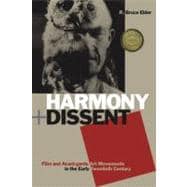
| Preface | p. ix |
| Acknowledgements | p. xxxi |
| Modernism and the Absolute Film | |
| The Overcoming of Representation | p. 1 |
| The Philosophical and Occult Background to the Absolute Film | p. 3 |
| Photography, Modernity, and the Crisis of Vision | p. 3 |
| The Analogy to Music | p. 5 |
| Absolute Film and Visibility: The Theories of Conrad Fiedler | p. 8 |
| Bergson and Intuition | p. 14 |
| Abstraction and the Occult | p. 15 |
| The Extraordinary Influence of Annie Besant and Charles Leadbeater's Thought Forms | p. 23 |
| Vibratory Modernism: Rudolf Steiner, Anthroposophy, and Synaesthesia | p. 31 |
| Modernism and the Absolute Film | p. 39 |
| The Absolute Film: Precursors and Parallels | p. 39 |
| Precursors of the Absolute Cinema: Light Sculpture | p. 39 |
| Precursors of the Absolute Film: The Scroll | p. 40 |
| Precursors of the Absolute Cinema: The Colour Organ and the Lichtspiel | p. 44 |
| More on Vibratory Modernism: The Esoteric Background to the Absolute Film | p. 81 |
| Abstract Film and Its Earlier Occult Predecessors | p. 86 |
| A Possible Egyptian Connection for Kircher's Steganographic Mirror | p. 94 |
| Huygens, Robertson, and Their Colleagues: Popular Magic | p. 101 |
| Spiritualism and the New Technology | p. 106 |
| Léopold Survage and the Origins of the Absolute Film | p. 111 |
| Walther Ruttmann and the Origins of the Absolute Film | p. 116 |
| Hans Richter and Viking Eggeling: The Absolute Film as the Fulfillment of Modern Art Movements | p. 125 |
| The Language of Art: Constructivism, Reason, and Magic | p. 129 |
| Eggeling's Integrity | p. 135 |
| Toward a Generalbaß der Malerei | p. 137 |
| Goethe as Precursor | p. 149 |
| Kandinsky, Eggeling, and Richter: Colour as Feeling, Rhythm as Form | p. 160 |
| Rhythmus 21 and the Generalbaß der Malerei | p. 162 |
| The End of the Absolute Film | p. 163 |
| Modernism and Revolution | |
| Constructivism between Marxism and Theology | p. 203 |
| Spiritual Interests in Late Nineteenth-Century and Early Twentieth-Century Russia | p. 205 |
| Symbolism, Theology, and Occultism | p. 205 |
| Solovyov's Influence | p. 216 |
| Symbolism and Its Legacies | p. 225 |
| Symbolism, the Spiritual Ideal, and the Avant-garde | p. 225 |
| Symbolism: The Crucible of the Russian Avant-grade | p. 227 |
| Malevich, or the Persistence of the Symbolist Ideal | p. 235 |
| Symbolism and Its Descendants: Suprematism | p. 239 |
| Zaum and Perlocutionary Poetics | p. 240 |
| Malevich and Higher Reality | p. 248 |
| Malevich, Suprematism, and Schopenhauer | p. 249 |
| Symbolism and Its Descendants: Cubo-Futurism | p. 251 |
| Vitebsk and Symbolism | p. 252 |
| Symbolism and Its Descendants: FEKS | p. 254 |
| Constructivism: Between Productivism and Suprematism | p. 265 |
| Symbolism and Its Descendants: Constructivism | p. 265 |
| Eisenstein, Constructivism, and the Dialectic | p. 279 |
| The Fact: Nature and Its Transformation | p. 280 |
| The Theory of the Dialectic and the Concept of Transformation | p. 289 |
| The Concept of Transformation in Earlier and Later Eisenstein | p. 291 |
| Eisenstein, Bely, Russia, and the Magic of Language | p. 301 |
| Rudolf Steiner's Anthroposophy and the Avant-garde | p. 304 |
| Rosicrucianism and the Theory of Transformation | p. 305 |
| What Would Eisenstein Have Heard in a Rosicrucian Lodge? | p. 308 |
| Rosicrucianism and Eisenstein's Aesthetic Theory | p. 312 |
| Constructivism and Counterscience | p. 317 |
| The Engineer of Human Souls | p. 331 |
| Fechner and the Science of Effects | p. 333 |
| The Cinema and Spiritual Technology | p. 338 |
| The Cinema and X-rays | p. 340 |
| Nikolai Fedorov's Cosmism | p. 346 |
| The New Body | p. 350 |
| Mexico and Mallarmé | p. 357 |
| Eisenstein, the Monistic Ensemble, and Symbolism | p. 364 |
| Eisenstein, Symbolism, and the Fourth Dimension | p. 369 |
| Eisenstein's Pangraphism and the Theory of Imitation | p. 383 |
| Mimesis, Pangraphism, and the Language of Adam | p. 389 |
| Eisenstein and Symbolist Colour Theory | p. 397 |
| Concluding Unscientific Postscript | p. 439 |
| Appendix Viking Eggeling's Diagonal-Symphonie: An Analysis | p. 445 |
| Shot Description/Analysis | p. 450 |
| Index | p. 465 |
| Table of Contents provided by Ingram. All Rights Reserved. |
The New copy of this book will include any supplemental materials advertised. Please check the title of the book to determine if it should include any access cards, study guides, lab manuals, CDs, etc.
The Used, Rental and eBook copies of this book are not guaranteed to include any supplemental materials. Typically, only the book itself is included. This is true even if the title states it includes any access cards, study guides, lab manuals, CDs, etc.